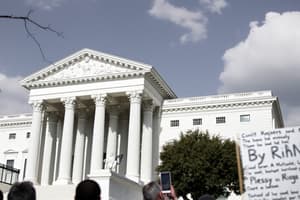Podcast
Questions and Answers
What was the primary legal reasoning in the Plessy v. Ferguson case regarding racial distinctions?
What was the primary legal reasoning in the Plessy v. Ferguson case regarding racial distinctions?
- Physical differences justify legal distinctions. (correct)
- Socially inferior races can be legally equated.
- All individuals have equal rights regardless of race.
- Legislation can erase social differences between races.
According to the arguments presented, how does the Supreme Court view the status of races?
According to the arguments presented, how does the Supreme Court view the status of races?
- Socially inferior races cannot claim equal status to superior races. (correct)
- All races should be treated equally under the law.
- Racial instincts can be legislated against successfully.
- Social inequality among races can be addressed by legislation.
What does the opinion in Plessy v. Ferguson suggest about the relationship between race and property rights?
What does the opinion in Plessy v. Ferguson suggest about the relationship between race and property rights?
- Racial identity influences legal recognition of property.
- All men have property rights regardless of race.
- Property rights are inherently tied to one's racial identity. (correct)
- Legislation can protect property rights across races.
In terms of social dynamics, what does the Plessy ruling imply about attempts to abolish racial distinctions?
In terms of social dynamics, what does the Plessy ruling imply about attempts to abolish racial distinctions?
What underlying message can be inferred from the legal context of Plessy v. Ferguson concerning societal views on race?
What underlying message can be inferred from the legal context of Plessy v. Ferguson concerning societal views on race?
Flashcards are hidden until you start studying
Study Notes
Plessy v. Ferguson (1896)
- Landmark Supreme Court case establishing "separate but equal" doctrine, legitimizing racial segregation.
- Homer Plessy, a mixed-race individual, challenged segregation laws by sitting in a "whites only" train car.
- The ruling emphasized legal inequality based on race, stating that legislation couldn't eliminate racial instincts or physical differences.
- Justice Henry Billings Brown asserted that social and legal inequities between races were constitutional under the current societal context.
Implications of the Ruling
- The decision reinforced systemic racism and justified segregation in public facilities and education.
- Legal foundation for Jim Crow laws, promoting an era of enforced racial division in the Southern United States.
- Dissenting opinions highlighted moral objections to segregation, foreshadowing future civil rights challenges.
Lynching in America
- Historical context of racial violence, particularly against African Americans, used as a tool of oppression and control.
- Lynching was often justified by societal beliefs in racial superiority and served as an intimidation tactic to suppress African American rights.
- Reflects broader themes of systemic racism and the struggle for civil rights in American history.
Studying That Suits You
Use AI to generate personalized quizzes and flashcards to suit your learning preferences.




